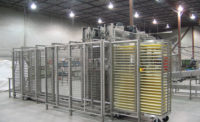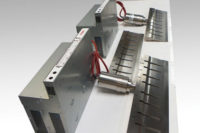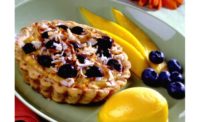New and redesigned pan-handling equipment, pans and pan coatings can help bakers and snack producers address production costs, downtime, changeover times and a host of other issues.
As when selecting food-processing machinery, bakers and snack manufacturers must consider numerous factors when investing in pan-handling equipment and pans. “Sanitation, noise and changeover are the issues we most frequently hear about from customers,” says Jerry L Barnes, vice president, engineering, Baker Thermal Solutions and Stewart Systems, Clayton, N.C., which offers a wide variety of pan and product conveyor equipment.
Baker Thermal Solutions thoroughly upgraded its Cyclone depanners last year to address these issues and others. “The systems have been specifically re-engineered for increased energy efficiency, low noise and automatic configuration,” Barnes explains.
Designed to remove bread, buns and other products (that may or may not contain seeds or toppings) from pans traveling through the baking system, the depanners are suitable for pans from 11-43 in. wide. An improved vacuum head design allows for greater suction range at lower operating costs. “This greater energy efficiency allows for smaller blowers with less attendant noise,” Barnes explains. “These blowers and optional, small-footprint Cyclones are mounted remotely to further reduce noise.”
Barnes adds that simplified HMI (human-machine interface) screens make the depanners easier to operate and troubleshoot. Recipe-based automatic changeover is available as an option, and can be synchronized with oven output. In addition, a specially profiled vacuum chamber assures gentle product handling, while a revamped, open-access design facilitates inspection, maintenance and sanitation.
“The most important issues we feel bakers are looking for in equipment design is worker and equipment safety, along with minimizing pan damage, while being handled to extend pan life expectancy,” says Robert Harrington, vice president of sales, Capway Systems Inc. “These two factors result in long-term savings and cost prevention for bakers or snack producers.”
The York, Pa.-based company offers an extensive line of pan-handling equipment, including conveyor systems, depanners, pan cleaners, oven loaders and unloaders and pan storage and retrieval systems. Most of the equipment is customized to meet customers’ needs.
Key features
A few years ago, Capway Systems also began manufacturing, under license from New Orleans-based Intralox, its patented i-Drive (Intermediate Drive) conveyor system. The modular belting conveyor features Intralox’s intermediate drive systems and allows allowing customers to combine multiple turns, inclines and straight runs for the entire distance needed for an application, which can be 30 ft. to several hundred feet long. Pans and product can travel, without transferring, from one conveyor to another in succession.
“The positive aspect of the i-Drive conveyor design is that when the pans and or product are transferred onto the system, they maintain their current position on the carrier belt for the entire distance of the conveyor, thus minimizing movement or skewing,” Harrington says.
Ken Johnson, president, Gemini Bakery Equipment Co., Philadelphia, agrees that noise, sanitation, changeovers, pan life and worker safety are all important issues for bakers and snack producers when selecting pan-handling equipment. He adds “an affordable level of automation to reduce labor costs” to that list.
“Gemini offers a broad range of equipment and systems that can be custom-designed to a customers’ specific needs,” he says. “Our strength is in our engineering expertise and depth of experience and knowledge. We custom-design our equipment and systems to provide the most affordable and effective solutions for our customers.”
For more than 40 years, Gemini Baking Equipment has been manufacturing and supplying the baking industry with a wide range of bun-pan, bread-pan and peelboard loading, handling, stacking and conveying equipment that can “accommodate just about any product that can be put in a pan or onto a peelboard,” Johnson says.
In addition, the company specializes in a variety of roll, bread, bagel and pizza makeup lines that produce and deposit these products into pans and onto boards via precise servo reciprocators. It also offers a line of industrial, high-speed floor rack pan and board loading and unloading equipment; a pick-and-place pan and board stacking and an unstacking system; cantilevered vacuum depanners; servo pick-and-place vacuum or needle depanners; robotic depanners; conveyors; tunnel oven loaders and unloaders; and all the associated components to create complete pan and board conveyorized systems for small, medium and large industrial production lines.
“We are the go-to-people for unique solutions for difficult applications,” Johnson says. “Manufacturers of the very popular pretzel rolls needed to proof product on peelboards, apply the lye solution and bake the rolls in pans. We designed a high-speed, high-volume system to very efficiently remove the rolls from the peelboards, apply the lye solution and redeposit the rolls into pans.”
Lake Forest, Ill.-based Colborne Foodbotics, meanwhile, offers a variety of special conveyors designed for various automation tasks, says Rick Hoskins, director of sales and marketing. “One of our most recent developments is our Anti-Shingling Pan Handling System, which is unique to the industry because of its ability to handle stock, rolled-edge pans in an automation environment,” he explains. “Traditionally, these pans are not compatible with automation because of their inability to back log and accumulate during an automation task.
“Until our development, bakers would have to use expensive and less efficient, flighted, indexing conveyors to handle these pans. Today, they can use a standard tabletop conveyor design that is continuous motion. This conveyor is more efficient in the transfer of pans and simpler from a conveyor design standpoint.”
Pans and coatings
Pan-handling equipment manufacturers aren’t the only ones offering bakers and snack producers new tools to make production more efficient and cost-effective. Pan manufacturers are also refining their products to meet these food producers’ needs.
Urbana, Ohio-based American Pan Co., a Bundy Baking Solutions company, introduced a new baking screen/baguette pan last year with a patent-pending, rivetless TabLock attachment that allows bakers to quickly remove and replace the pan’s baking screen. The company received a B.E.S.T. in Baking recognition for the new pan at last year’s International Baking Industry Exposition (IBIE).
The new pan design offers bakers numerous benefits: They don’t have to ship the pans back to the manufacturer to have the screens drilled out and replaced, thus reducing fuel consumption, carbon dioxide (CO2) emissions, energy consumption and downtime. The design can also improve employee safety by eliminating the need to remove rivets as well as eliminates the possibility of metal shavings or rivet ends falling into products. Because the screens and frames are recyclable, bakers can reduce their solid waste.
Lloyd Industries Inc., Spokane Valley, Wash., added a new finish option for its Lloyd Pans line last year, which comprises commercial pans (cheesecake and angel food, bread, sheet, pie and cake rings) for the baking industry, pans for the pizza industry and custom pans. Lloyd Pans’ products are manufactured in the U.S. and constructed of premium direct-cast aluminum alloy.
The new Silver-Kote bright finish is an eco-friendly coating that requires no pre-seasoning and won’t impact the quality of the baked product through discoloration, pan staining or flavor leeching, says Evelyn Ainley, account manager. It joins Dura-Kote, the company’s other proprietary, water-based, stick-resistant, solvent-free finish.
“There are no chemicals to leach into foods and no harmful toxins to release into the environment,” Ainley says of the finishes. “Unlike competitive glazed pans, our pans aren’t susceptible to water and steam damage that can cause premature failure and damage to the pan’s surface.”
In addition, the proprietary, permanent finishes never require recoating and make pans resistant to warping, denting and scratching, even under tough baking environments. “Eliminating reglazing costs that include shipment to a coating facility and back represents a significant savings for our customers,” Ainley notes.
Bakeware Coating Systems Inc. (BCS), meanwhile, is the exclusive U.S. applicator of BCS-Teflon, a grade of Teflon designed specifically for commercial bakers by DuPont, Wilmington, Del. “[It] gives a long life and the best value-performance combination,” says Steve B. Schwartz, president of the Philadelphia-based company. “There are lots of coatings available on the market that are ‘off-the-shelf.’ Many people make promises about them but, at the end of the day, when BCS-Teflon is put up head to head with those coating, it always lasts the longest.”
BCS finishes new and used bread, bun, roll, cake, snack cake and baguette/Mecatherm pans using custom coatings formulated for bakers’ applications, such as gluten-free breads, egg-washed products and pretzel rolls. The benefits of recoating, rather than replacing, pans are numerous, according to Schwartz. “Bakers who have a high-volume bun product running 70-80 cycles a week typically have to get their pans glazed every six or seven weeks,” he explains. “With us, pans get coated perhaps once a year. Not only are bakers saving money in terms of the cost of the [BCS-Teflon] coating versus the cost of the silicone glaze, they also don’t have the labor of taking the pans off the line, sending them out and putting them back on the line. The pans can be running full time. You can never get back those lost days.”
Schwartz adds that pans coated with BCS-Teflon are also easy to clean and offer a consistent bake from the first day they go on the line until the day they come off the line. “With a silicone-glazed pan, for example, the bake changes from day one,” he explains. “Silicone absorbs water, so as a silicone-glazed pan is used, water carries carbonized product into the surface and the glaze gets darker and darker. This changes the bake and forces the baker to make adjustments.”
In terms of cakes or snack cakes, BCS-Teflon-coated pans result in less crumb in the pan, Schwartz says, enabling bakers and snack producers to use less oil or other release agents. “It reduces the mess in the bakery, and the amount of BOD (biochemical oxygen demand) that might be going out into the wastewater.”
Investing in the right pan-handling equipment, pans and pan coatings can help bakers and snack manufacturers address a variety of production issues, from worker safety and noise to sanitation and changeover times. Equipment, pan and coating suppliers are taking note and developing the tools that these food producers need to succeed.











